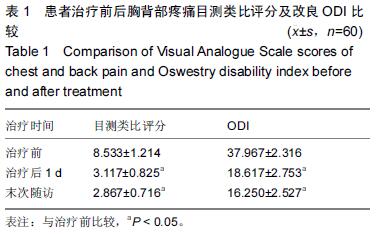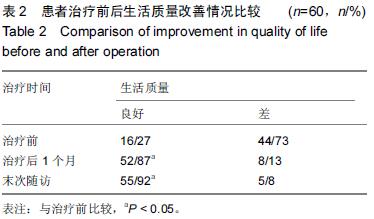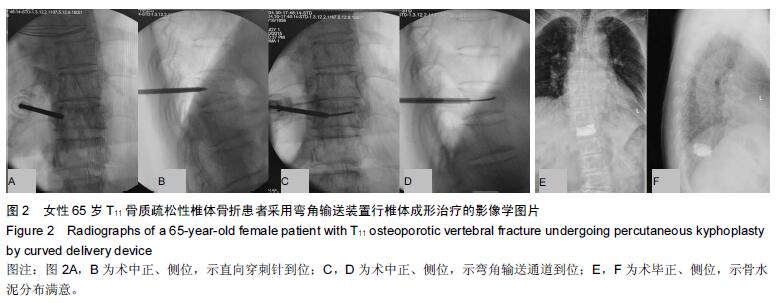| [1] Galibert P, Deramond H, Rosat P, et al. Preliminary note on the treatment of vertebral angioma by percutaneous acrylic vertebroplasty.Neurochirurgie.1987;33:166-167. [2] Wang JC, Liu ZD, Yang JD, et al. Improved percutaneous vertebroplasty for osteoporotic vertebral compression fractures.Chin J Orthop Traum. 2012; 14(3):216-219. [3] Burton AW,Hamid B.Kyphoplasty and vertebroplasty. Curr Pain Headache Rep. 2008;12(1):22-27. [4] Rapadeo A. General management of vertebralfractures. Bone. 1996;18:191-196. [5] Division of Mental Health.Field trial WHOQOL-100:The 100 questions With response scales WHO, GeneVa, 1995. [6] Alvarez L,Perez-Higueras A,Granizo J,et al.Predictors of outcomes of percutaneous vertebroplasty for osteoporoticvertebral fractures. Spine.2005;30:87-92. [7] Hoh BL,Rabinov JD,Pryor JC,et al.Balloon kyphoplasty for vertebral compression fracture using a unilateral balloon tamp via a unipedicular approach: technique note. Pain Phys. 2004,7:111-114. [8] Kin AK,Jensen ME,Dion JE,et al.Unilateral transpedicular percutaneous vertebroplasty: initial experience. Radiology. 2002;22(2): 737-741. [9] Murphy KJ, Lin DD, Khan AA, et al. Multilevel vertebroplasty via a single pedicular approach using a curved 13-gauge needle: technical note. Can Assoc Radiol J. 2002;53(5): 293-295. [10] Knavel EM,Rad AE,Thielen KR,et al. Clinical outcomes withhemivertebral filling during percutaneous vertebroplasty. AJNR Am J Neororadiol. 2009;30(3): 496-499. [11] Theocharopoulos N, Perisinakis K, Damilakis J,et al. Occupational exposure from common fluoroscopic projection used in orthopaedic surgery. J Bone Joint Surg Am. 2003;85:1698-1703. [12] Liebschner MAK,Rosenberg WS,Keaveny TM.Effects of bone cement volume and distribution on vertebral stiffness after vertebroplasty. Spine. 2001;26:1547-1554. [13] Chen BL,Li YQ,Xie DH,et al.Effects of unipedicular and bipedicular kyphoplasties on stiffness and biomechanical balance of the compression-fractured vertebral bodies. Chin J Orthop Trauma. 2011;13(3): 251-255. [14] Belkoff SM, Mathis JM, Fenton DC,et al. An exvivo biomechanical evaluation of an inflatable bonetamp used in the treatment of compression fracture. Spine.2001; 26(14):151-156. [15] Brugieres P, Gaston A, Heran F, et al.Percutaneous biopsies of the thoracic spine under CT guidance: transcostovertebral approach. Compur Assist Tomogr. 1990;14(3):446-448. [16] Boszczyk BM, Bierschneider M, Hauck S, et al. Transcostovertebral kyphoplasty of the mid and high thoracic spine. Eur Spine J. 2005;14(10):992-999. [17] Ryu KS,Park CK,Kim MK,et al.Single balloon kyphoplasty using far lateral extrapedicular approach: technical note and preliminary results. Spinal Disord Tech. 2007;20(5):392-398. [18] Ryu KS,Huh HY,Jun SC,et al.Single-balloon kyphoplasty in osteoporotic vertebral compression fractures:far-lateral extrapedicular approach. Korean Neurosurg Soc. 2009;45(2):122-126. [19] Wang S,Wang Q,Kang J,et al.An imaging anatomical study on percutaneous kyphoplasty for lumbar via a unilateral transverse process-pedicle approach. Spine(Phila Pa 1976).2014;39(9):701-706. [20] Baumann C,FuchsH,Jürgen K,et al.Complications in Percutaneous Vertebroplasty Associated with Puncture or Cement Leakage. Cardiovasc Inter Rad. 2007;30(2): 161-168. [21] Heo DH,Cho YJ.Segmental artery injury following percutaneous vertebroplasty using ertrapedicular approach. J Korean Neurosurg Soc. 2011;49(2): 131-133. [22] Puri AS,Colen RR,Reddy AS,et al. Lumbar artery pseudoaneurysm after percutaneous vertebroplasty:a unique vascular complication. J Neurosurg Spine. 2011; 14(2):296-299. [23] Potet J, Weber-Donat G, Curis E, et al. Incidence of Pulmonary Cement Embolism after Real-Time CT Fluoroscopy-guided Vertebroplasty. Vasc Interv Radiol. 2013; 24:1853-1860. [24] Boger A,Heini P, Windolf M,et al.Adjacent vertebral failure after vertebroplasty: a biomechanical study of low-modulus PMMA cement. Eur Spine. 2007;16(12): 2118-2125. [25] Kinzl M,Benneker LM,Boger A,et al.The effect of standard and low- modulus cement augmentation on the stiffness,strength,and end plate pressure distribution in vertebroplasty.Eur Spine J. 2012;21:920-929. [26] Wang CY, Fan SW, Liu JH. Basivertebral foramen could be connected with intravertebral cleft: a potential risk factor of cement leakage in percutaneous kyphoplasty. Spine J. 2014;14:1551-1558. [27] Venmans A,Klazen CA,Lohle PN.Percutaneous vertebroplasty and pulmonary cement embolism: results from Vertos II.Am J Neuroradiol. 2010;31:1451-1453. [28] [Bohner M,Gasser B,Baroud G,et al.Theoretical and experimental model to describe the injection of a polymethylmethacrylate cement into a porous structure. Biomaterials. 2003;24(16):2721-2730. [29] 唐振华,桂红利,伍正华. 经横突椎弓根入路和经椎弓根入路单侧穿刺行椎体成形治疗OVCF的临床疗效分析[J].现代医药卫生,2014,30(12):1830-1831. [30] Chu W, Tsuei YC, Liao PH, et al. Decompressed percutaneous vertebroplasty: A secured bone cement delivery procedure for vertebral augmentation in osteoporotic compression fractures. J Injury. 2013;44(6): 813-818. [31] 李鹏.弯角椎体成形穿刺装置的研制及应用研究[D].军医进修学院,2012. [32] Srinivasan D, Than KD, Anthony C, et al. Wang.Radiation Safety and Spine Surgery: Systematic Review of Exposure Limits and Methods to Minimize Radiation Exposure World Neurosurg. 2014;82(6):1337-1343. [33] Kim SM, Kim JU, Lim JH, et al. Delayed complication of vertebroplasty: intradural penetration of previous PMMA leakage after trauma. Spine J. 2015; (15): 1146–1149. [34] Corcos G, Dbjay J, Mastier C, et al. Cement leakage in percutaneous vertebroplasty for spinal metastases: a retrospective evaluation of incidence and risk factors.Spine (Phila Pa 1976). 2014;39(5): E332-338. [35] Ha KY, Lee JS, Kim KW, et al. Percutaneous vertebroplasty for vertebral compression fractures with and without intravertebral clefts. Bone Joint Surg (Br). 2006;88(5): 629-633. [36] Xing D,Ma JX,Ma XL,et al.A meta-analysis of balloon kyphoplasty compared to percutaneous vertebroplasty for treating osteoporotic vertebral compression fractures. Clin Neurosci. 2013;20(6):795-803. [37] Murphy KJ, Lin DD, Khan AA, et al. Multilevel vertebro-plasty via a single pedicular approach using a curved 13-gauge needle: technical note. Can Assoc Radiol J. 2002;53(5): 293-295. [38] Kaufmann TJ, Trout AT, Kallmes DF. The effects of cement volume on clinical outcomes of percutaneous vertebroplasty. AJNR Am J Neuroradiol. 2006;27(9): 1933-1937. [39] Lyster M,Symington K,Stalcup J,et al.Osseoplasty: Review and Analysis of 1081 Cases in the United States and Europe. Available at: http://www.osseon.com/wp- content/uploads/1081-Patient-Case-Study.pdf Soon WC,Mathew RK,Timothy J,et al.Comparison of vertebroplasty using directional versus straight needle.J Acta Radiol Open. 2015;4(3):2047981615569268. |
.jpg)



.jpg)
.jpg)
.jpg)